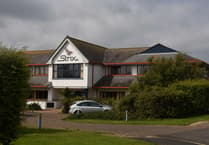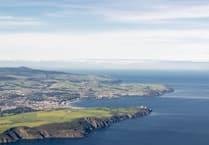Many know the story of the Dunkirk evacuation and the role played by the Isle of Man Steam Packet Company. But less well-known is the part it played in a later evacuation from St Nazaire.
It was a story passed on at one or two generations remove. It seemed an incredible coincidence but my dad said it was true. War throws up the most unlikely situations and this was one of them.
The coincidence saw two men - one a Londoner and one a Peel man - play a part in a grim episode of war. And although they didn’t know it at the time, they would meet when the war caused their paths to cross again.
The role of Steam Packet ships in lifting thousands of men from danger at Dunkirk was rightly commemorated earlier this month. It was a mission which saw them rescue 25,000 men but lose three of their ships to enemy action.
But what is less well-known is that the rescue mission continued for another three weeks and would see ships, including some from the Steam Packet, race to lift thousands more men from France as the Germans advanced through the country.
My grandfather, Bert Wade, was a soldier. He was born in Edmonton, North London and joined the Army in 1923. He left the regular army in 1930 and joined the Army reserve. After the outbreak of war in September 1939, he re-enlisted, joining the Royal Engineers at Folkestone Racecourse a month later. He was sent to France in November as part of the British Expeditionary Force.
My great grandfather, Henry Hughes, although not serving in the military himself in 1940, was in the Royal Navy during the First World War. When peace came he was demobilised and came back to the island, finding work with the Isle of Man Steam Packet Company. It was there he was working in 1939 when war came again.
Around 338,000 fighting men were saved from Dunkirk, but on June 3 the town was overrun. By June 14, the Germans had entered Paris and those thousands of British soldiers and airmen still in France raced towards the coast ahead of the advancing Nazis. Among them was Bert, who was based at Nancy in Eastern France, hundreds of miles from the coast.
As he and thousands of other British soldiers and airmen sought safety, Operation Aerial was put into action. Just as Operation Dynamo covered Dunkirk, so Aerial covered all efforts to evacuate British servicemen from ports like Brest, La Rochelle, Bordeaux and St Nazaire.
Bert recalled hitching lifts as they headed for St Nazaire. When he finally reached the port he would have been surrounded by chaos.
To deny the Germans, fuel and equipment, oil storage tanks were set alight, vehicles were sabotaged, driven into the sea or torched. A pall of black smoke hung over the port and weapons lay abandoned. The docksides at St Nazaire were crowded with thousands of men desperate to escape capture or death at the hands of the advancing Germans.
Their spirits would have been lifted, though to hear that ships were anchored further out in the Loire estuary ready to take them home.
One of them was the British ocean liner Lancastria.
She had already helped evacuate troops from Norway in April 1940 and had just returned from ferrying soldiers to Iceland when she got the call to sail for France. She arrived at the mouth of the Loire estuary late on June 16.
That same night the French request for an armistice was sent to Hitler. Time was running out for Bert and for the thousands of British troops still in France.
By 4am the next day, she anchored five miles off St Nazaire due to the tides and later in the morning smaller craft began to take passengers to her. Exhausted troops and some civilians boarded her and were given tickets with their cabin and deck number. Some were given spaces in the ship’s holds. Their relief can be imagined.
As Bert and his unit waited far back from the mass of men crowded on the quay, they would have scanned the skies nervously as German aircraft continued to attack.
The Lancastria could normally take 2,100 passengers as a troopship. This time she was told to take as many as she could ’without regard to the limits of International Law’. Her captain said she could take 3,000 ’at a pinch’. Estimates vary, but by early afternoon she had 6-9,000 passengers on board.
Now, with the Lancastria crammed with evacuees, Bert and his pals would discover there was no more room and they would not be boarding. More ships would come, but as the Germans came closer, would they come in time?
Not far out to sea, Henry Hughes was sailing on a Steam Packet ship. Despite their losses at Dunkirk, again they were going to the aid of British servicemen in peril.
It seems probable he was on the Lady of Mann. Bert and Henry were about to witness what was, and still is, Britain’s worst maritime disaster.
At 2.50pm, the bridge of a smaller merchant vessel loading troops, the Oronsay, was hit in a dive-bomber attack. The Lancastria was advised to leave but the captain opted to wait until the Oronsay was ready to depart and they would have a destroyer escort. It was to be a fatal decision. An hour later German Junkers 88s bombers swooped down aiming for the liner. They dropped their bombs, one exploding close to the ship’s port side and rupturing her fuel tanks. Another was reported to have gone straight down her funnel - although this is disputed.
She was hit many times and began to list to starboard, which made it impossible to launch all of her lifeboats.
By 4.10pm, she was gone - all within 20 minutes of being hit. More German planes appeared which machine-gunned hapless survivors in the water. Many died from hypothermia and fewer than 2,500 survived.
Bert and his pals on the quay had had a narrow escape. Later that day he was embarked on one of the ships lying off St Nazaire and by the next day, the evacuation was complete.
Bert was then sent to do a very different job. As Britain faced the threat of invasion in 1940, thousands of German and Italian civilians and British fascists were rounded up and taken to internment camps in the Isle of Man. Bert was stationed in Peel, guarding Peveril camp.
It was after he came to Peel that he met my nan, Gladys Hughes. He was introduced to her father, my great-grandfather Henry, although he might have been surprised by his daughter’s romance with the gruff Londoner, they would both have their military service in common.
He and Henry would talk about their experiences, especially what they had just been through. The younger man would have told the sailor where he had just come from and the rest would have been clear. They both had witnessed this harrowing event far, far away.
In those dark times there would be some light for Bert and for Henry. They both made it safely back to Britain. Bert and Gladys would have two children together, grandchildren for Henry and his wife Winifred.
Bert would survive the war and live happily in Peel with his new family and his father-in-law; two men whose paths had crossed, both in the carnage of war-torn France and the peace of the Isle of Man.
Eighty years ago, just weeks after the Dunkirk evacuations, over 100,000 British troops remained in France, desperate to escape the advancing Nazis. As at Dunkirk, the Isle of Man Steam Packet Company again went to their aid and on June 17 1940, a Peel sailor would witness the sinking of a troopship with the loss of thousands of lives off St Nazaire. Unbeknown to him, it would also be seen by his future son-in-law, a soldier from England who was on the quayside waiting to be rescued.
MARTIN WADE tells the story of the sinking of the Lancastria, and the unlikely coincidence which would see both his grandfather and great-grandfather witness the worst maritime disaster in British history.




